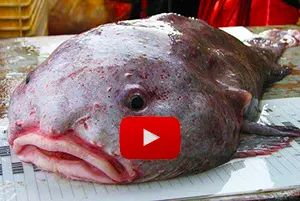Blobfish – Ugliest Animal in the World?
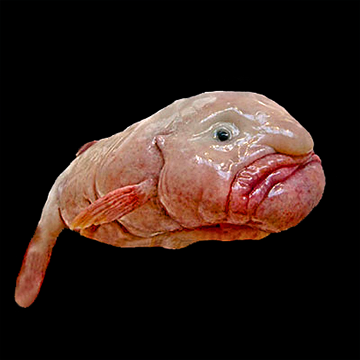
Contents
What is a Blobfish?
The blobfish is a deep-sea fish with a smooth, gelatinous pink body, bulbous head, black eyes, and a large snout with a big down-turned mouth. Its most notable feature is its lighter-than-water body of soft, jelly-like cartilage. This unique squishy body allows the blobfish to withstand the immense water pressure found at depths of 600-1,200 meters below the deep-sea surface where it lives. In its natural deep-sea habitat, off Australia and New Zealand, the blobfish looks like a normal bottom-dwelling fish, the high water pressure keeping its body in shape.
However, when a blobfish is brought to the surface and taken out of the water, its body immediately loses its shape and collapses into an unattractive, gooey blob, earning it the title of the "world's ugliest animal". (See our excellent explanation of this phenomenon below).
Why the Blobfish Becomes a Blob? - The Blobfish’s Blobbiness Explained
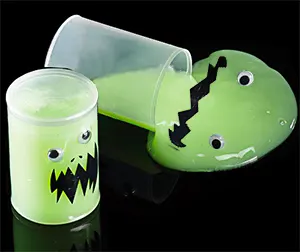
Photo: How a Blobfish's body keeps its shape
Here is a real-life example of why the blobfish looks just fine underwater but turns into a blob when taken out of the water.
We all know of the gooey stuff kids play with called "Slime". Now, when the slime is in its container, the sides of the container keep it in shape. In this case, the shape of the container puts pressure on the slime, forcing it into shape. Similarly, the pressure of the water acts like a container and keeps the blobfish's body in shape.
However, when you remove its container, the Slime no longer has something forcing it to have a shape. So it becomes blobby and has no particular shape. The same principle applies to the blobfish. It is designed to work under pressure. The water acts like a container.
Blobfish Lives Deeper than A Submarine Can Go
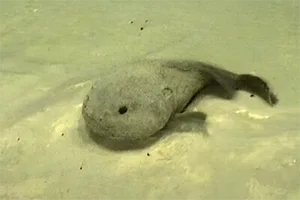
Photo: Blobfish swimming underwater
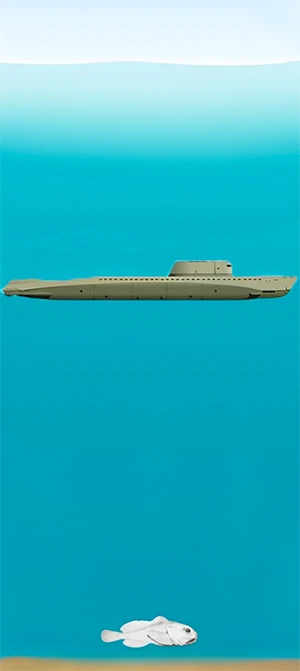
Photo: Depth at which blobfish live
The depth at which the blobfish swims is more than 2.5 times deeper than the most powerful submarine can go. A submarine, if it were to go this deep, would be crumpled like a tin can by the water pressure, which is over 100 times greater than on land. Only specially designed undersea rovers can go down to these depths.
Blobfish Habitat Where Does the Blobfish Live?
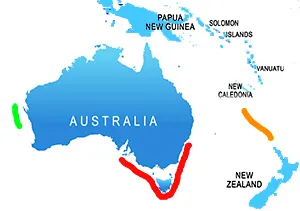
Photo: Blobfish Habitat Map
The blobfish lives in the oceans off the coast of Australia and New Zealand, at depths of 1,000 meters near the seafloor. No sunlight reaches this deep ocean. As a result, there are no plants or other vegetation of any sort. The water temperature is just above freezing (2 - 4 degrees Celsius). Except for a rare photograph taken by a deep-sea rover underwater vehicle, no human has observed blobfish in their natural habitat.
Three types of blobfish are found close to Australia. Their habitats are colour-coded in the map. The Smooth-head Blobfish ( Psychrolutes marcidus) is found off the coasts of southern Australia. The Western Blobfish ( Psychrolutes occidentalis) lives off Western Australia. And "Mr Blobby" (Psychrolutes microporos) lives near Norfolk Island.
Blobfish Diet
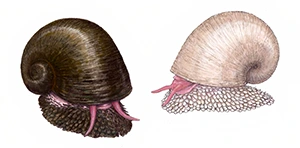
Photo: Snails and sea slugs are part of blobfish diet
The blobfish eats crustaceans, larvae, sea slugs, sea snails, sea urchins, and dead biomass drifting down from the ocean above. It is a lie-in-wait predator that spends most of its time just floating around, waiting for food to come its way. It then quickly sucks the food into its enormous mouth.
There is very little food in the depths at which the blobfish lives. Scientists believe its body structure, with very few muscles, a very low metabolic rate, and slow movement, helps it conserve energy and survive on a very limited diet.
Blobfish Reproduction & Life Cycle
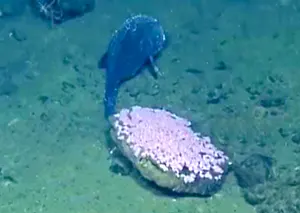
Photo: Blobfish guarding its eggs
The female blobfish lays tens of thousands of tiny, pink eggs in a nest on the ocean floor. Then she and her partner hover over the eggs to protect them from predators.
The blobfish can grow to 30cm (1ft) and weigh around 2kg (2.2lb). It has a typical lifespan of 10 to 15 years but may live to over 100 years. Its scientific name is Psychrolutes marcidus, and it is in the Psychrolutidae family.
Blobfish Predators & Threats
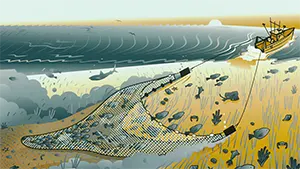
Photo: Deep-sea trawling captures blobfish
The biggest threat to blobfish is deep-sea trawling. Fishing nets cast to extreme depths unintentionally capture blobfish, which rarely survive the journey to the surface.
Because so little is known about the blobfish, we do not know if it has any natural predators or threats.
Are Blobfish Endangered?
The short answer is we just do not know how many blobfish are left in the world or if they are endangered. Some people claim that there are only 430 blobfish in the world. This is fake news and not based on any credible scientific evidence. The World Wildlife Fund and the International Union for Conservation of Nature (IUCN) do not list the blobfish as endangered.
So, the blobfish may be rarely seen, but there is no evidence that it is extinct or endangered.
Sad Story of Mr Blobby - Winner of the Ugliest Animal in the World Award
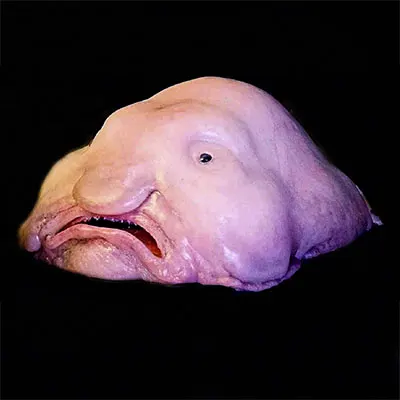
Photo: Blobfish - Ugliest Animal in the World
Mr. Blobby was a blobfish caught in 2003, approximately 1,300 kilometres off the coast of eastern Australia. Based on photographs of Mr. Blobby, the blobfish was voted the "World's Ugliest Animal." The contest wasn't really fair. Mr Blobby was out of water and dead. However, the Ugly Animal Preservation Society had good intentions when it voted the blobfish the ugliest animal in 2013. It is trying to raise awareness of endangered animals that don't grab the public's imagination because they are ugly.
Mr. Blobby measured 285 millimetres in length and weighed 1.7 kilograms. Although referred to as Mr. Blobby, it is unknown whether this fish was male or female, as it was never dissected.
Mr Blobby had his "fifteen minutes of fame". He was an overnight media sensation. Today, Mr Blobby sits alone in a bottle preserved in 70% ethyl alcohol on a shelf in the Australian Museum Ichthyology Collection (AMS I.42771-001). He no longer looks like the photos. His skin has tightened, his eyes sunken, and his distinctive nose has shrunk—poor Mr Blobby.
Can You Eat a Blobfish?
Yes, you can eat a blobfish. But because its body is gelatinous (like Jell-O) and mainly made up of water, the blobfish tastes like a tasteless blob of jelly.
25 Blobfish Facts
- The blobfish lives off the coast of Australia.
- It is a deep-sea fish that swims or floats at depths of 1,000 meters or more.
- The blobfish's body is designed to work under extreme pressure.
- Water around it acts as a container and compresses blobfish’s body into shape.
- For this reason, in the ocean, it looks like a giant tadpole. On land, it's a blob.
- The blobfish has no hard bones. Instead, its skeleton is made from soft, flexible cartilage.
- The blobfish has no teeth. So, a blobfish can't bite its food. It just swallows its food whole.
- The blobfish has hardly any muscle. Just enough to operate its gills, open its mouth and move its fins very slowly.
- The blobfish's low muscle mass and usage mean it uses very little energy.
- Only underwater deep-sea rovers can reach the underwater depth where the blobfish lives.
- Unlike most fish, the blobfish has no swim-bladder to keep it from sinking.
- Instead, its body is made of a gelatinous substance lighter than water.
- Because its body is lighter than water, it floats effortlessly at whatever depth it likes.
- It floats by adjusting the water content of the gelatinous mass in its body.
- By doing this, the blobfish makes itself lighter or heavier.
- It has no scales.
- It is not an active hunter. It waits for food to come its way.
- The blobfish female lays thousands of tiny, pink eggs.
- Nobody knows if the blobfish is endangered because so little is known about them and their population numbers.
- The blobfish named Mr Blobby was voted the ugliest animal in the world.
- Yes, you can eat a blobfish. But it is quite tasteless.
- Another sea creature that has a gelatinous body is the jellyfish.
- The blobfish has a lifespan of up to 130 years.
- Three types of blobfish are found in the oceans around Australia.
- The blobfish is not dangerous.
